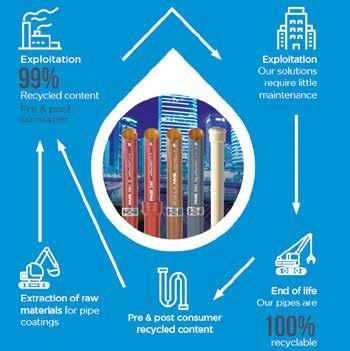
3 minute read
Circular economy
04 CIRCULAR ECONOMY:
PAM BUILDING, A KEY PLAYER IN THE CIRCULAR ECONOMY
The preservation of natural resources is a major societal challenge, especially for the construction sector, which is a major consumer of raw materials and energy. PAM Building’s systems are a responsible and sustainable choice, respectful of natural resources and people.
A cast iron pipe gives our waste a second life 100% recyclable indefinitely without losing any of its properties and made from 99% recycled content*
For the standard Ensign Soil, recycled content is 99% with pre-consumer** & post-consumer*** according to ISO 14021: 1999.
In order to contribute to the preservation of natural resources, PAM Building’s molten iron is produced by recycling cast iron and ferrous products. It is also completely and systematically recycled at the end of its life without any deterioration of its properties. Thanks to the inherent commercial value of scrap metal the recycling of it is a very well established market that will continue indefinitely. Thanks to its 70 year lifespan the requirement for recycling is kept to a minimum during the infinite life of the raw material. Through our constant innovation this lifespan will continue to increase.
Nothing is wasted: everything is recycled
Cast iron pipe systems are based on the principle of modular ranges of removable components. Their mechanical assemblies are reversible. You can change your mind today or even tomorrow. When pipe systems are disassembled or modified, these components can be reused, which cuts down on the need for recycling.
*Recycled content: proportion, by mass, of recycled material in a product or packaging. Only pre-consumer and post-consumer materials shall be considered recycled content. ** Pre-consumer material: material diverted from the waste stream during a manufacturing process. This excludes the reuse of materials such as rework, regrind, or scrap generated in a process and capable of being reclaimed within the same process that generated it. *** Post-consumer material: material generated by households or commercial, industrial and institutional facilities in their role as end users of the product which can no longer be used for its intended purpose.
“Did you know that, in 2019, we have recycled the equivalent weight of 18,300 cars“
From 99% recycled waste to 100% fully recyclable
An established recycling industry
The recycling industry is mature and well established with the end to end process operating efficiently. We work with local supply for scrap (<125 km from the plant) to reduce economic and transport costs. Following ISO 14021:1999 and LEED V4 criteria we can provide a recycled content declaration for our products, such as:
Recycled content declaration Ensign range drainage system
We declare that the percentage of scraps included in the composition of drainage solution (pipes andfittings), manufacturedby Saint-Gobain PAM Building is the following:
pre-consumer content 11,5 % post-consomer content 87,5%
Following ISO 14021:1999, the recycled content is 99% by weight:
Recyled content (ISO 14021:1999) = post-consomer content + pre-consumer content
Following LEED v4 “Building product disclosure and optimization - sourcing of raw materials” criteria, the recycled content is 93% by weight:
Recycled content (LEED v4) = post-consumer content +1/2 pre-consumer content
October 2020 SAINT-GOBAIN PAM Building

Focus on a recent initiative: Recycling of the old Parisian drinking water network in our Bayard plant
The Parisian drinking water pipe network is principally made of cast iron from different technological developments since the 19th century and located in the sewer galleries. The old cast iron pipes dating from before the beginning of the 20th century are coated with a coal pitch coating. During their renewal, they need to be taken to a specific treatment area for coal pit residues. A recycling service for old cast iron pipelines has been developed in our Bayard plant in order to meet the environmental requirements of Eau de Paris 1st public company of water in France. Several pilot projects have demonstrated the practicality from a technical and organisational point of view and proven the potential industrialisation of pipe recycling.
The main stages of the recycling process for old cast iron pipelines
Pipes before removal Storage of old and new pipes Use of return flow
Production of new pipes for drainage system Reflections in the cupola at the Bayard plant Bayard plant





